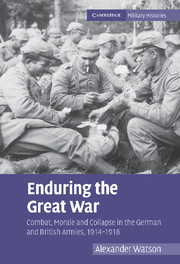Book contents
- Frontmatter
- Contents
- List of plates
- List of figures
- List of tables
- Acknowledgements
- List of abbreviations
- Map: The Western Front 1914–1918
- Introduction
- 1 War of endurance
- 2 Why men fought: combat motivation in the trenches
- 3 Self-deception and survival: mental coping strategies
- 4 Junior leadership: command, cohesion and combat motivation
- 5 Morale and military endurance
- 6 The German collapse in 1918: strike, mutiny or an ordered surrender?
- Conclusion
- Appendix 1 Walter Ludwig's study of Württemberg soldiers' coping strategies
- Appendix 2 Psychiatric casualties in the German and British armies
- Appendix 3 Military ranks and status in the German and British armies
- Glossary of German terms
- Bibliography
- Index
Appendix 1 - Walter Ludwig's study of Württemberg soldiers' coping strategies
Published online by Cambridge University Press: 05 February 2014
- Frontmatter
- Contents
- List of plates
- List of figures
- List of tables
- Acknowledgements
- List of abbreviations
- Map: The Western Front 1914–1918
- Introduction
- 1 War of endurance
- 2 Why men fought: combat motivation in the trenches
- 3 Self-deception and survival: mental coping strategies
- 4 Junior leadership: command, cohesion and combat motivation
- 5 Morale and military endurance
- 6 The German collapse in 1918: strike, mutiny or an ordered surrender?
- Conclusion
- Appendix 1 Walter Ludwig's study of Württemberg soldiers' coping strategies
- Appendix 2 Psychiatric casualties in the German and British armies
- Appendix 3 Military ranks and status in the German and British armies
- Glossary of German terms
- Bibliography
- Index
Summary
Walter Ludwig's investigation of soldiers' coping strategies is probably the most sophisticated piece of psychological research to be undertaken on either side during the First World War. Ludwig served as an infantry officer on the Western Front, fought against British and French troops in the Vosges, the Argonne, the Somme and at Ypres and was wounded three times. He conducted his study, however, during two brief periods out of the line, while acting as a teaching officer at an officer training course and a teacher at a school for wounded. In total, 200 pupils were asked to write an essay entitled, ‘Beobachtung aus dem Feld, an was der Soldat im Augenblick der höchsten Gefahr denkt, um die Furcht vor dem Tod zu überwinden’ (‘Observations from the field regarding what the soldier thinks in the moment of greatest danger in order to overcome the fear of death’). After the war, Ludwig analysed the essays by picking out the themes which he identified as most common and important and rating them for frequency. Personal statements on soldiers' own thoughts in danger were separated from general observations of how men acted or thought in danger. His results are reproduced in Table 4.
- Type
- Chapter
- Information
- Enduring the Great WarCombat, Morale and Collapse in the German and British Armies, 1914–1918, pp. 236 - 237Publisher: Cambridge University PressPrint publication year: 2008



